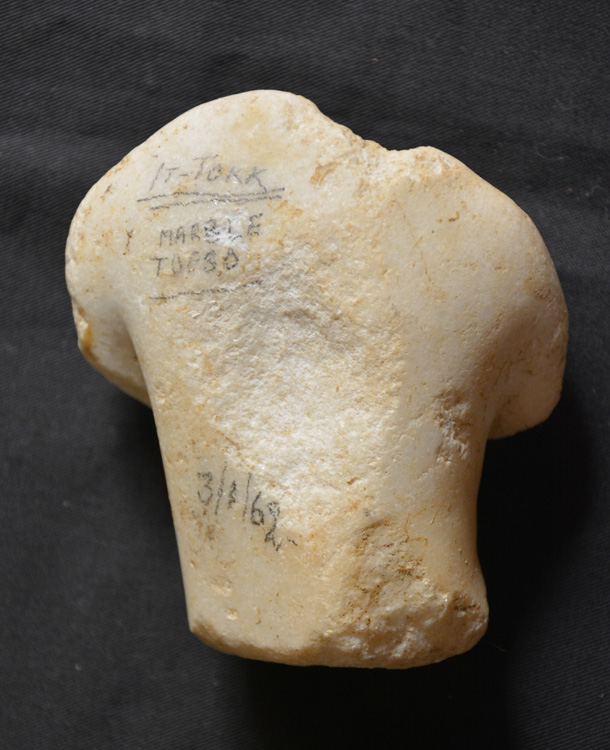Upper half of a female nude statuette
Category
Gozo GroupAbout This Artefact
I.D. no: 32346
Dimensions: Max. H. 9 cm; Max. W. 8 cm.
Material: Medium-grain white marble
Provenance: From the Main Square of Rabat, Gozo[1]
Current location: Museum of Archaeology, Gozo
Condition: Broken just above the waist, the surviving upper torso lacks also the head and both arms. The head seems to have been inserted separately, as suggested by the hollow between the shoulders. Both breasts are heavily abraded and smaller chips affect various parts of the body surface. The central area of the back has been ground down to a shallow hollow. A circular hole has been freshly drilled for display purposes.
Description: The torso belongs to a nude female figure with rather small breasts in asymmetrical relation to the shoulders. The upper body is heavily flexed to its right in relation to its lower body. More or less the same treatment is given to the back as to the front.
Discussion: The statuette is deprived of any evidence of attributes or drapery, but the inclination of the shoulders and the position of the arms permit the suggestion of a fair guess regarding its typology, namely, that of Aphrodite at the bath. The type owes its origin to the Aphrodite of Knidos by Praxiteles.[2] It is known through various replicas and copies of them that abounded in the ancient Hellenistic and Roman world.[3] The Gozo fragment replicates also the upper torso of the half-naked ‘Aphrodite Pudica’ from Lepcis Magna, so-called for her gesture to hide her nudity.[4] Sometimes the positions of the chest and shoulders are reversed.[5] The difference in the inclination of the body suggests that the Gozo statuette was inspired by copies of the Knidian type[6] rather than the Capitoline type,[7] or Medici type.[8]
Apart from the size, the bad state of preservation precludes an adequate critical judgment of the statuette. It generically belongs to rather low quality craftsmanship, probably of the early imperial period.
Bibliography: (previous publications of item): Unpublished.
[1] The note written in pencil on the back reads: ‘It-Tokk marble torso 3/1/1962’. No reference is found in the Annual Report of the Museum Department for 1962. A long trench for a deep drain pipe cut in the same square the previous year had yielded interesting archaeological material, but no mention is made of statuary (Annual Report of the Museum Department for 1961: 5).
[2] Corso 2007: 9-187.
[3] Many examples in different sizes and states of conservation in Corso 2007: e.g. figs 44-45, 48, 53, 58, 61, 74, 77, 86, and others.
[4] Caputo & Traversari 1976: no 37; Delivorrias et al. 1984: vol. II,1: 49-54.
[5] Padgett 2001: 196-97 (probably of an Aphrodite Anadyomene). See Delivorrias et al. 1984: passim.
[6] Blinkenberg 1919-20; Blinkenberg 1933: pls 1-13; Rizzo 1932: pls 70-85; Delivorrias et al. 1984: vol. II,1: 48-52.
[7] Jones 1912: 182-84, no.1, pl. 45; Delivorrias et al. 1984: vol. II,1: 52-53; Corso 2007: fig. 13.
[8] Mansuelli 1958: 69-74, no 45; Delivorrias et al. 1984: vol. II,1: 53.


